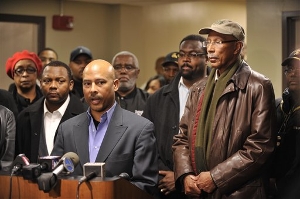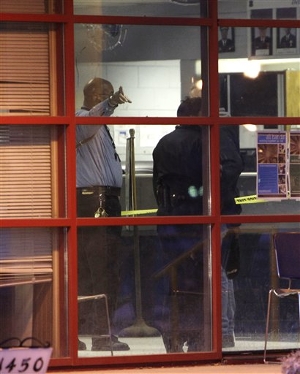
Detroit Police Chief Ralph Godbee, center, speaks at a press conference Sunday Jan. 23, 2011 about the shootings at a Detroit Police precinct Sunday afternoon, Jan. 23, 2011. A man entered the precinct and started shooting police officers, injuring four officers before he was shot and killed by return fire from the police. Detroit Mayor Dave Bing, right, attended the press conference at Sinai-Grace Hospital in Detroit, where three of the officers are being treated. (Associated Press)
When a gunman went on a rampage inside a Detroit police station this week, he entered an open lobby with no metal detector, no bulletproof glass and just a tall desk separating him from the officers. The place had been designed as part of a "community policing" strategy to look friendly and less bunker-like.
Now, in the wake of the shootout Sunday that left four cops wounded and the gunman dead, some big-city police departments and police unions around the country are taking another look at their security measures and grappling with how to serve the public while also protecting officers' lives.
"Our commitment to community policing, engaging the community, will not change one iota," Detroit Police Chief Ralph Godbee said Monday. "But by the same token, the society we live in dictates that we have to take a different level and a different look at how we secure our facilities."
At least one criminal justice expert warned that the bloodshed could lead police departments to roll back community policing, which has been widely credited with contributing to the big drop-off in violent crime in many U.S. cities over the past two decades.
Michael Josephson, founder and chief executive of the Josephson Institute, a Los Angeles-based nonprofit organization that provides ethics training for law officers, said it would be a mistake for police to circle the wagons and conclude that they are "policing the enemy."
"You cannot adequately reduce the risks unless you truly want to make it an army base," Josephson said. "I'd be having town-hall meetings right now. . . . I hope some leaders see this as an opportunity to build bridges instead of walls."
After the riots and civil unrest of the 1960s and '70s, many big-city police departments began adopting community policing, which is aimed, in part, at fighting crime by convincing the public that the police are not the enemy. Some departments made officers start walking a beat again so that they could get to know the neighborhoods they protected. Cities tried to make police stations look less like fortresses.

Detroit police point to a broken window at the precinct 6 building in northwest Detroit where a gunman walked into the police station and opened fire injuring three police officers, Sunday, Jan. 23, 2011. (Associated Press)
In six of the seven local police stations in Milwaukee, residents can walk right up to officers behind counters, though Michael V. Crivello, president of the police union, said he hopes the department reconsiders in light of the rampage in Detroit.
In New York City, which has the nation's largest police department with more than 34,000 uniformed officers, each precinct has officers assigned as security, and their job is to greet visitors. Department spokesman Paul Browne said people "have to be able to feel welcome to make a report or ask for help."
After the shooting in Detroit, the New York Police Department sent out an order to all precincts to be vigilant at the doors and make sure the security posts are staffed.
There have been no shootings inside a New York station during the city's historic crime drop over the past two decades. In 1993, a drug suspect inside a New York station house wrested away a gun and wounded two officers, then killed himself. Afterward, police installed video cameras and boosted security.
In Buffalo, N.Y., where officers sit behind glass at most stations, the police department is assessing security to see if more protection is needed in light of the Detroit violence.
A Los Angeles police spokeswoman said her department is constantly evaluating security. But she said it has no plans to introduce bulletproof glass at front desks, which are under video surveillance.
Not all big cities have embraced community policing in all its forms. Each of Dallas' seven substations has bulletproof glass between officers and the public, as do precincts of Florida's Miami-Dade County force.
Thomas Nee, president of the Boston police union, warned that a push to place civilians instead of full-fledged officers at the front desks at some neighborhood police stations is putting police at risk. Nee, also president of the National Association of Police Organizations, said violence against police has gone up "exponentially" recently, and "what we need is armed, trained, professional police officers."
The gun battle in Detroit was particularly brazen, and came during a month when 14 officers in the U.S. were killed and a 24-hour period in which 11 officers were shot.
Sgt. John Delmonico, president of the police union in Minneapolis, where the front desks in some precincts are behind thick plates of glass and others are open, said there is no easy answer to how to protect officers' lives.
"If somebody wants to hurt a cop, they can hurt a cop," he said. "I don't think there's a formula you could change where you could say, 'Oh, I feel safe now.'"
Maki Haberfeld, chairwoman of John Jay College's Department of Law, Police Science and Criminal Justice Administration in New York, said the violence against police represents "an epidemic of a lack of respect" for law enforcement. She said episodes such as the Detroit shootout underscore the limits of community policing.
"You cannot always assume the entire community out there is going to cooperate with police just because police officers are trying to cooperate with the community," she said. "Police risk their lives to protect society and they should be afforded an elevated status of protections."
In Detroit, Peggy Anderson, the wife of wounded Sgt. David Anderson, said at a hospital Tuesday that she was happy when her husband "took a job inside the precinct, thinking, 'Oh, he's safe now.'"
"This isn't right," she said. "We have to take control of this city. These things shouldn't happen."
Since the shooting, a metal detector has since been installed at the entrance of the 6th Precinct station where the gunman walked in. The station, built in the mid-1980s, sits between a business district, a residential area and a row of manufacturing buildings on the city's west side. The precinct serves a large area with pockets of high crime.
Former Detroit Sgt. David Malhalab, who spent 23 years on the force before he retired in 2005, worked at the 6th Precinct, where the desks were in open view of anyone walking in the door.
"I was always very comfortable working the desk because I wanted that one-on-one feeling with the public," he said, "but I thought it was an accident waiting to happen, and it did."











